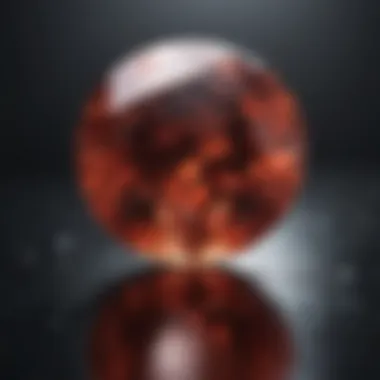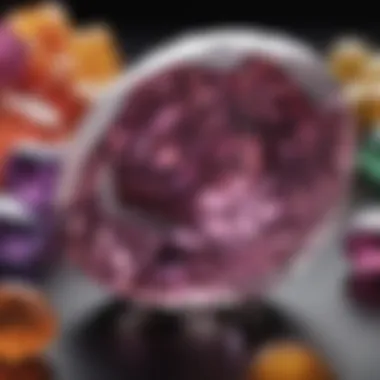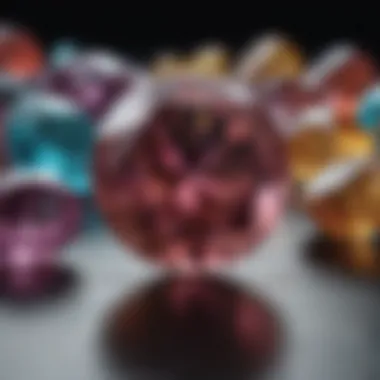Understanding VVS Clarity in Gemstones and Its Value


Intro
In the world of gemstones, clarity plays a crucial role in determining both the aesthetic appeal and the value of a stone. One specific clarity grade that stands out in this conversation is VVS, which stands for Very Very Slightly Included. Understanding this grading can help potential buyers make informed choices, enabling them to choose high-quality pieces that suit their preferences and investment needs.
Clarity is just one of the four primary characteristics often evaluated in gemstones. The others include color, cut, and carat weight. However, clarity can significantly impact the visual brilliance of a gem, especially when viewed under light. This article aims to peel back the layers of complexity surrounding VVS clarity, offering insights that will benefit both casual enthusiasts and serious collectors alike.
Gemstone Overview
Definition and Characteristics
A gemstone is defined as a piece of mineral crystal, or other organic materials, which, after being cut and polished, is used for decorative purposes or as a form of artistic expression. The characteristics that define gemstones include their brilliance, color, transparency, and hardness. Each gem type boasts unique attributes that contribute to its overall desirability and market value.
Classification of Gemstones
Gemstones are generally classified into two categories: precious and semi-precious. Precious gemstones include diamonds, rubies, sapphires, and emeralds. These stones are highly coveted due to their rarity and visual beauty.
Semi-precious stones, on the other hand, can include a wide range of materials, such as amethyst, garnet, and turquoise. While they often offer unique beauty, they are typically less expensive and more readily available.
In many instances, the perceived value and classification of gemstones can evolve, depending on current trends and market demands. Thus, understanding the nuances of clarity and its impact on value is essential for anyone engaged in the gemstone market.
Properties of Gemstones
Physical Properties
The physical properties of gemstones include aspects like hardness, luster, and specific gravity. Hardness, often measured by the Mohs scale, indicates a stone's resistance to scratching or abrasion. Luster refers to the way a surface interacts with light, while specific gravity pertains to the density of the gemstone compared to water. Each of these attributes plays a role in the practical uses of gemstones, as well as their appeal.
Chemical Properties
Chemical properties of gemstones provide insight into their composition. Each gemstone is made up of specific minerals and elements that contribute to its color and other characteristics. For example, diamonds are primarily composed of carbon, while sapphires consist of aluminum oxide with trace elements that provide their color. A deeper understanding of these properties not only aids in distinguishing between different types of gemstones but also informs collectors and investors about potential care and value considerations.
"Understanding the basic properties of gemstones is vital for anyone looking to appreciate their beauty and investment potential."
Ultimately, clarity, particularly VVS clarity, stands as a mark of quality that can elevate a gemstone's appeal. This marks the starting point for understanding how clarity influences not just a gemstone's beauty, but also its desirability and resale value.
Prelude to Clarity in Gemstones
Clarity is a fundamental component in the evaluation of gemstones. It refers to the presence of imperfections, known as inclusions or blemishes, within a stone. Understanding clarity is critical for several reasons. First, it greatly affects the aesthetic appeal of a gemstone. A higher clarity means fewer visible inclusions, leading to a more beautiful and desirable stone. Additionally, clarity plays a crucial role in the overall value of the gemstone. Better clarity often commands a higher price in the market. Therefore, knowing how to assess clarity is vital for buyers, sellers, and collectors alike.
What is Clarity?
Clarity indicates how clear a gemstone appears to the naked eye. This assessment involves examining internal and external characteristics. Inclusions are internal flaws that may result from the stone's natural formation, while blemishes refer to surface imperfections. Clarity is usually graded on a scale that includes categories such as Flawless (F), Internally Flawless (IF), Very Very Slightly Included (VVS), Very Slightly Included (VS), Slightly Included (SI), and Included (I). The determination of a stone's clarity is key in identifying its quality and potential use in jewelry.
Importance of Clarity in Gemstones
The significance of clarity cannot be overstated. It directly influences how light interacts with a gemstone, impacting its brilliance and sparkle. For instance, a stone with high clarity tends to reflect light better, thus enhancing its visual appeal. Furthermore, clarity affects market demand. Gemstones that display superior clarity are often more sought after, leading to better investment opportunities.
"High clarity in gemstones elevates their aesthetic beauty and market value, making clarity assessment essential for collectors and jewelers alike."
When purchasing gemstones, buyers often consider clarity alongside color, cut, and carat weight. High clarity stones usually signify a quality product, improving the likelihood of future value appreciation. Collectors particularly value stones with high clarity for their rarity and aesthetic qualities. Therefore, understanding clarity is vital for navigating the gemstone market effectively.
The Gemstone Grading System
The gemstone grading system is fundamental to understanding the quality and value of gemstones, especially when it comes to clarity. Clarity refers to the presence or absence of internal or external imperfections in the gemstone. In the broader context of grading, clarity plays a crucial role alongside other factors such as color, cut, and carat weight. A clear understanding of these grading principles enables buyers to make informed decisions, ensuring that their investments are sound.


A robust grading system helps establish a common language in the gemstone industry. It allows gemologists, jewelers, and buyers to communicate effectively about the characteristics of gemstones. This system also provides transparency in the buying process, fostering trust between buyers and sellers.
Furthermore, clarity directly influences the aesthetic appeal of the gemstone. The clearer the stone, the more light it can refract, creating a dazzling visual effect. As such, clarity often becomes a pivotal factor in pricing. Higher clarity grades typically demand higher prices, signifying their desirability in the market.
Overview of the Grading Scale
Gemstones are generally graded using a scale that categorizes clarity into specific grades. The grading system often follows guidelines established by major gemological laboratories, such as the Gemological Institute of America (GIA). These grades typically range from included (I) to flawless (IF). The most recognized grades within this system are the following:
- Flawless (IF): No inclusions visible under 10x magnification.
- Very Very Slightly Included (VVS1 & VVS2): Inclusions are very difficult to see, even for a skilled gemologist under 10x magnification.
- Very Slightly Included (VS1 & VS2): Inclusions are visible under 10x magnification but are minor and do not greatly affect beauty.
- Slightly Included (SI1 & SI2): Inclusions are visible to a trained eye under 10x magnification and may affect brilliance.
- Included (I1, I2, I3): Inclusions are noticeable and significantly impact the gem's appearance and durability.
This scale is essential for gemstone buyers, allowing them to gauge the quality of the stone they are purchasing. Understanding where a stone falls on this scale can also aid collectors who wish to meet specific criteria for their collections or investments.
Understanding Clarity Grades
Clarity grades serve not only as a benchmark for quality but also as a critical aspect of the purchasing process. When considering clarity, it is essential to comprehend how these grades affect the overall visual appeal of a gemstone. Higher clarity grades usually correlate with greater rarity; therefore, buyers often pay a premium for stones that fall within the VVS category or above.
Each grade considers factors such as the type, size, location, and number of inclusions. For instance, a VVS gemstone will have minor flaws that are nearly impossible to detect without professional examination. In contrast, a VS grade gemstone may have more apparent inclusions, albeit still mostly subtle.
The grading review also assesses the impact of these inclusions on the gemstone's light performance. A well-graded stone can handle light in a way that captivates the viewer, whereas a lower-grade stone may struggle with brilliance due to visible flaws.
In takeaway, understanding the grading of clarity equips gemstone enthusiasts and buyers with insights that lead to more judicious purchasing decisions. Knowledge of the grading system and clarity implications on visual appeal can enhance the overall experience for anyone involved in the gem market.
Defining VVS Clarity
When venturing into the realm of gemstones, one encounters numerous terms, among which clarity reigns supreme in determining a stone's overall quality. Within this context, VVS clarity emerges as a pivotal classification. Understanding what VVS means and its implications can significantly affect gemstone evaluation and selection for both enthusiasts and collectors. VVS stands for "Very, Very Slightly Included." It is a grade assigned to gemstones that display negligible inclusions visible only under magnification. The importance of VVS clarity cannot be overstated, as it serves not only as a marker of quality, but also influences aesthetic appeal and market value.
What Does VVS Mean?
VVS clarity refers to a specific level on the clarity grading scale used primarily in the evaluation of diamonds and other gemstones. A gemstone classified as VVS contains minute imperfections that are difficult to detect even under 10x magnification. These inclusions do not significantly interfere with the stone's brilliance or perceived beauty. The distinction between the two levels of VVS—VVS1 and VVS2—depends on the nature of the inclusions and their visibility. A VVS1 stone features even less visible inclusions than a VVS2 stone, making it more desirable in the market.
- VVS1: Very, Very Slightly Included 1—includes inclusions that are extremely hard to see under magnification.
- VVS2: Very, Very Slightly Included 2—includes inclusions that are slightly more noticeable under the same magnification.
The definitions and nuances of these terms are crucial while purchasing or evaluating gemstones. Moreso, to thoroughly appreciate the VVS quality level, one must consider how these inclusions interact with light and overall gemstone aesthetics.
Differences Between VVS and Other Clarity Grades
To grasp the significance of VVS clarity, it is essential to delineate it from other clarity grades, such as VS (Very Slightly Included) and SI (Slightly Included).
- VVS vs. VS: VS stones feature inclusions that are more apparent under magnification, making them less desirable when compared to VVS stones. The presence of visible inclusions can detract from the overall allure of a gemstone, even though VS stones may still be of high quality.
- VVS vs. SI: SI stones have inclusions that are distinctly visible to the naked eye and under magnification. These inclusions can significantly impact the gemstone's brilliance and aesthetic value. A VVS stone, by contrast, maintains its visual integrity despite minor inclusions.
In summary, the variance in clarity grades not only affects beauty but also influences market perceptions and investment potential.
Examining VVS Clarity Characteristics
In gemstone evaluation, understanding the characteristics of VVS clarity is crucial. This clarity grade, meaning "Very Very Slightly Included," showcases stones with minimal internal flaws, often invisible to the naked eye. Knowing these details assists buyers and collectors in making informed decisions and appreciating the stone's value.
Identifying VVS Stones
When identifying VVS stones, one must focus on the inclusions. Inclusions are internal flaws that can affect a gem's beauty and value. VVS gemstones may have minute inclusions visible only under 10x magnification. Jewelers and appraisers employ tools such as jewelry loupes for examination, helping ensure authenticity and quality. It is essential for potential buyers to understand what to look for.
Key characteristics of VVS stones include:
- Subtle and tiny inclusions
- Hardly visible, even under close scrutiny
- Often a mark of a higher quality gemstone
- Generally, more desirable in terms of aesthetics and resale value


Visual Appearance of VVS Gemstones
Visually, VVS gemstones possess a remarkable clarity that impacts their overall appearance. The lack of significant inclusions allows light to move freely through the stone, enhancing brilliance and color saturation. This clarity not only adds to aesthetic appeal but often results in a more captivating display of hues.
Several factors contribute to the visual characteristics of VVS stones:
- Brilliance: Exceptional light performance due to minimal impediments.
- Color Depth: Vivid color appearance, as inclusions can dull hues.
- Transparency: High levels of transparency lead to stunning visual effects.
How Light Interacts with VVS Clarity
Light interaction is another critical aspect when examining VVS clarity. The minimal inclusions present in these stones allow for optimal light refraction. This means light enters the stone and exits without excessive scattering or absorption, leading to a vibrant and lively appearance.
Important points about light interaction include:
- Light travels through the gemstone efficiently, maximizing brilliance.
- The absence of glaring inclusions ensures that the primary color is prominent and vivid.
- Light plays a significant role in showcasing a gemstone's unique qualities, especially in VVS stones.
Quality gemstones not only catch the eye but also tell a story of their unique formation and beauty. Having knowledge about VVS clarity equips gem enthusiasts with valuable insights, allowing them to appreciate these remarkable stones on a deeper level.
The Impact of VVS Clarity on Value
Understanding the impact of VVS clarity on gemstone value is essential for gemstone enthusiasts and collectors alike. Clarity significantly influences the overall quality and market demand of a gemstone. VVS, or Very Very Slightly Included, denotes a high level of clarity in gemstones. This quality translates into both aesthetic appeal and market perception, making VVS stones highly sought after.
Market Perception of Clarity Grades
Gemstones are often evaluated closely for their clarity, and VVS clarity is perceived as a hallmark of excellence. Consumers frequently associate clarity with rarity and, by extension, beauty. Because VVS stones contain minimal inclusions that are nearly impossible to detect without magnification, they are viewed as superior to lower clarity grades.
The market often reacts positively to VVS stones. As a result, these gemstones tend to command higher prices compared to their VS (Very Slightly Included) or SI (Slightly Included) counterparts. This heightened interest is driven by several factors:
- Aesthetic Appeal: VVS stones are more visually pleasing. Their limited inclusions enhance their brilliance and color.
- Rarity: VVS stones are rarer than lower clarity grades, contributing to their desirability.
- Investment Value: Many collectors view the purchase of VVS clarity gemstones as a solid financial investment due to their potential for appreciation in value.
Overall, the perception of VVS clarity plays a crucial role in the gemstone market, affecting both consumer choices and pricing strategies.
Investment Considerations for VVS Stones
Investing in VVS clarity stones can be both rewarding and complex. The value of these stones can fluctuate based on changes in demand and market trends. Potential investors should consider the following aspects:
- Quality Assessment: When purchasing VVS stones, obtaining a reliable gemological report is vital. Reports from reputable organizations provide a detailed analysis of the stone’s qualities, including clarity.
- Market Trends: Stay updated on market trends and consumer preferences. Understanding what influences the buying behavior can aid in making informed investment choices.
- Long-Term Value: VVS stones might yield a higher return on investment over time, especially if market demand increases. However, potential buyers should focus on long-term value rather than short-term profit.
Investing in VVS clarity gemstones is not just a financial endeavor but also an appreciation for the natural beauty and craftsmanship involved.
"The quality of clarity in gemstones can profoundly affect both aesthetic enjoyment and financial investment."
Common Misconceptions about VVS Clarity
In the realm of gemstones, VVS clarity often comes with a set of misconceptions that can mislead potential buyers and collectors. These misunderstandings are not just trivial; they can impact purchasing decisions and overall knowledge about gemstone quality. To clarify the significance of VVS clarity, it is essential to debunk these myths and provide accurate insights. Misconceptions can often create a biased view that affects how gemstones are perceived and valued in the market.
Educating oneself about VVS clarity and its placement in the grading system ensures informed decisions. By exploring these common misconceptions, enthusiasts can appreciate not just the visual allure of stones but also understand their true quality and value.
VVS vs. VS: Clearing the Confusion
When discussing clarity in gemstones, the terms VVS (Very Very Slightly Included) and VS (Very Slightly Included) often come up. These two grades are close but differ in subtle yet meaningful ways.
A VVS grade indicates that any inclusions present are extremely difficult to detect even under 10x magnification. In contrast, a VS graded stone will have slight inclusions that are somewhat easier to see when examining under the same magnification. While VVS stones are generally more valued, some buyers might misinterpret this to mean they are always the better choice.


Here are key points to understand the differences:
- Detection: VVS inclusions are nearly invisible, while VS inclusions are visible upon closer inspection.
- Value: VVS stones typically command higher prices due to their lesser imperfections.
- Aesthetic: Both grades can present beautiful options but VVS may be favored for high-end jewelry.
Recognizing these differences helps buyers make informed choices, particularly if they are considering investment or acquisition for collections.
Are VVS Stones Always Superior?
A common belief is that VVS stones are always superior to their VS counterparts, yet this is not the full picture. The notion of superiority lacks nuance. Few factors contribute to a gemstone's ultimate value and desirability. While VVS stones may appear purer under magnification, other elements play a crucial role.
Consider the following factors:
- Cut Quality: Even a VVS stone with a poor cut can underperform in terms of brilliance and light return compared to a well-cut VS stone.
- Color: In some cases, the color grade of a gemstone can elevate a VS stone beyond the appeal of a VVS stone, especially in colored gemstones.
- Market Demand: Specific gemstones can see fluctuating demand, which means a VS stone in a sought-after type could be more valuable than a mediocre VVS stone.
In summary, while VVS stones deserve recognition for their clarity, superiority should not be viewed as absolute. The value and appeal of a gemstone rest on multiple parameters, making buyer education critical in any purchase related to gemstone clarity.
Evaluating Gemstones: Tips for Buyers
Evaluating gemstones is a crucial process for buyers who want to ensure that they are making informed decisions. This section outlines the specific elements to consider, the benefits of careful evaluation, and important considerations when purchasing gemstones, particularly those with VVS clarity. Understanding the nuances of gemstone evaluation can lead to the acquisition of pieces that not only resonate aesthetically but also hold intrinsic value.
What to Look for in VVS Clarity Stones
When considering VVS clarity stones, there are several key aspects buyers should focus on:
- Visual Inspection: Look for stones that have minimal inclusions. In VVS stones, these are tiny and only visible under magnification. Use a jeweler's loupe to check for any notable imperfections.
- Brilliance and Fire: Evaluate how light interacts with the gemstone. Good quality VVS stones will exhibit superior brilliance due to their clarity, enhancing their overall appearance.
- Cut Quality: The way a gemstone is cut significantly impacts its display of clarity and light performance. A well-cut VVS stone will reflect light more effectively.
- Shape and Size: Different shapes may show clarity differently. Consider the size versus the perspective of clarity—larger stones may display inclusions more prominently than smaller ones.
- Color: A rich color can enhance the visual appeal of a clarity stone. Clarity should complement the color, which adds to the overall value.
"A VVS clarity stone is an investment. Asking the right questions and knowing what to look for can make a significant difference in selecting the perfect piece."
Understanding Lab Reports
Lab reports provide essential information about a gemstone's characteristics and grade. These documents are critical for buyers who want to verify the authenticity and quality of VVS clarity stones. Here are some key components of a lab report:
- Certification Grading: Look for reports from reputable labs such as the Gemological Institute of America (GIA) or the American Gem Society (AGS). Their grading system will usually provide a clarity grade clearly defined.
- Detailed Descriptions: The report should detail the stone's specifics, including origin, any treatments if applicable, and a precise description of clarity grade.
- Photographs of the Stone: Many lab reports include images that show characteristics under magnification. This helps in understanding how the stone will appear in natural light.
- Comparison with Industry Standards: The lab report will offer insights compared to industry standards. This includes valuation aspects, market insights, and recommendations for purchase.
Reviewing a lab report is essential for unswayed confidence while evaluating gemstone purchases. Buyers should familiarize themselves with the terminology used in reports to make the best-informed choices.
Epilogue: The Significance of VVS Clarity
VVS clarity plays an essential role in understanding the overall quality and value of gemstones. It refers to Very Very Slightly Included stones. Such inclusions are nearly invisible to the naked eye, making VVS stones desirable for both aesthetic beauty and investment potential. As we conclude this exploration of VVS clarity, it is important to recognize the unique position these gemstones hold in both the market and among collectors.
VVS gemstones are often sought after due to their superior clarity which enhances their brilliance and visual appeal. As a gemstone collector or enthusiast, understanding this clarity scale can markedly influence purchasing decisions. It offers an appreciation for the finer details in gemstone quality that can only be fully understood with knowledge of clarity grades.
Furthermore, the variance in pricing for gemstones can significantly hinge on clarity distinctions. A VVS clarity stone might command a premium because of its near flawless appearance compared to lower clarity grades. This correlation between clarity and value emphasizes the necessity of recognizing VVS clarity as not merely a grading component, but a crucial factor in investment and desirability.
"Gemstone clarity significantly affects perceived value and beauty."
Understanding VVS clarity allows buyers to make informed choices that align with their aesthetic preferences and budget. It facilitates an appreciation for the minor differences that elevate some stones from ordinary to exceptional. As we delve into the details, it becomes evident that not all VVS stones are identical, even if they fall within the same clarity category. Factors such as cut, color, and the presence of rare characteristics can also play a role in distinguishing one VVS stone from another.
Final Thoughts on Clarity in Gemstones
The significance of clarity transcends the mere grading of stones. As we have discussed, clarity has far-reaching implications regarding aesthetic appeal and valuation. A VVS gemstone, with its subtle beauty and remarkable clarity, can inspire admiration among gem enthusiasts and collectors alike. This clarity ensures that these gemstones not only hold financial value but also serve as beautiful artifacts of nature.
When evaluating gemstones, clarity should not be the only consideration; however, it serves as a pivotal element in assessing quality. It informs buyers on how a gemstone may interact with light and how it appears in different settings. The VVS designation signifies an elevation in rarity and quality that impresses both collectors and jewelers.
Future Perspectives on Gemstone Clarity
Looking forward, the landscape of gemstone clarity grading may evolve. Advancements in technology and gemstone treatment processes could influence how clarity is perceived. As synthetic gemstones become more prevalent, understanding natural stones with VVS clarity will remain an integral part of the gemstone conversation.
Additionally, with increasing awareness about ethical sourcing and sustainable practices, gemstone enthusiasts may focus more on gemstones that not only have superior clarity but also come from responsible origins. This shift could change market dynamics, making clarity in natural stones even more valuable.



